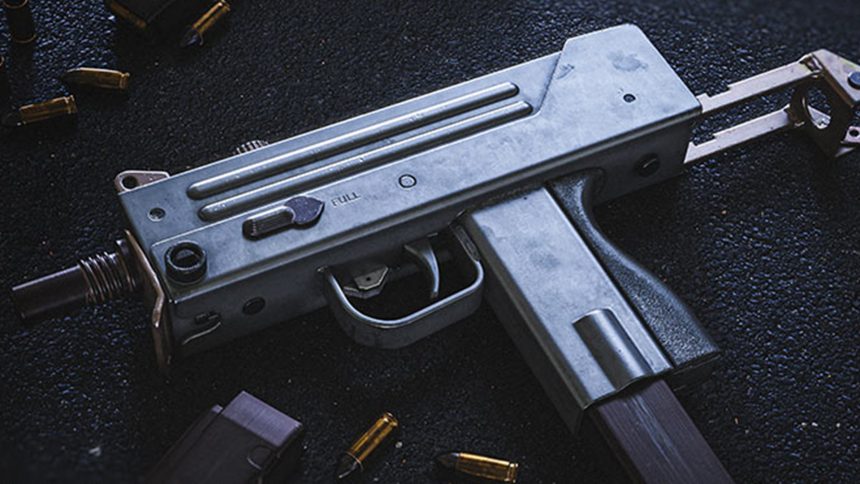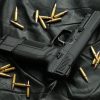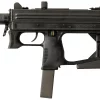MAC-10 is a compact blowback-operated weapon, classified as a machine pistol and submachine gun. It is chambered in either .45 ACP or 9 mm. Gordon B. Ingram developed it in 1964 as a weapon intended to supply special operations, law enforcement forces, and VIP security teams that needed small, compact, and powerful weapons.
Introduction
Interestingly, the original designation of this weapon was Military Armament Corporation Model 10 (M10, M-10) and has never been referred to as the MAC-10 by the manufacturer. The MAC-10 designation was frequently used by Title II dealers, gun writers, and collectors. Although it was widely used in Hollywood movies, this semi-automatic version of MAC-10 was forbidden in the US under the assault weapons ban enacted by Congress in 1994.
Gordon B. Ingram designed the MAC-10 in 1964, and Military Armament Corporation delivered prototypes in 1965 for the US Army evaluation, but Army was not satisfied, and the MAC-10 wasn’t adopted. Unfortunately, the weapon was not adopted due to the poor performance at formal testing; terrible triggers and poor magazines contributing to multiple stoppages were just two of the complaints.
Design
MAC-10 was purportedly designed for close encounters and concealed carrying. It is interesting to mention that it was designed around a suppressor. According to the rumors, when the Sionics sound suppressor appeared, designers put the MAC-10 design together around it.
It has a simple blowback-operated design open bolt, similar to the one used on the Israeli IMI Uzi. As mentioned earlier, MAC-10 is chambered in .45 ACP and 9×19 mm, two baseline models. Both models are simple in design and technology, compact but cheap to manufacture.

The weapon’s receiver is made of sheet steel and consists of only two parts. These are held together by a steel pin. Cocking handle is located at the top of the gun. It does not reciprocate when the gun is fired. The weapon can be reloaded with either hand. The cocking handle is also safety, as it locks the bolt forward when turned 90 degrees sideways. You can not see the front sight when this safety is on, as the sighting line is blocked. Another safety switch is located inside the trigger guard.
A separate fire mode selector is located above the trigger guard on the left side of the receiver. It has settings for single shots and full-auto firing. The MAC-10 is fed from a box-shaped magazine inserted in the pistol grip. The .45 ACP model comes with 30-round magazines, while the model chambered for 9×19 mm ammunition is fed from 32-round magazines. Users can fire this weapon by holding it with one hand, in the same manner as firing pistols.
A leather loop is attached to the front of the weapon. It can be held by a non-firing hand and provides additional stability. The Ingram M10 has simple non-adjustable diopter-type sights. The sighting range is set at 100 m. However, the effective range of fire is limited to around 50-70 meters. Accuracy suffers as this weapon is uncomfortable to hold with both hands, making it hard to compensate for the recoil force. This submachine gun comes with a telescopic steel wire stock. Some of its versions were fitted with the detachable wooden buttstock.

MAC-10 was designed to use a rather sizable and heavy suppressor (which would reduce muzzle climb) and be fired from the shoulder with the wireframe stock. (which would increase accuracy) The suppressor was sufficiently insulated that you could hold onto it like the forend of a standard rifle or SMG. Suppressors on this weapon are pretty efficient. Due to the short barrels of the MAC-10, bullets leave the weapon without generating enough muzzle velocity to cause a sonic boom.
Manufacturer
In 1976 the MAC went bust, and production rights for this weapon were transferred to RPB Industries Inc. Later, some other companies also manufactured this submachine gun. Military Armament Corporation exported Ingram’s submachine guns to Chile, Yugoslavia, and other Asian and South American countries. This weapon was manufactured in Japan, South Africa, and Taiwan. Today the MAC-10 is no longer a premier submachine gun. However, it is still used by around 15 countries.
Variants
MAC-11 (or M11), chambered for a smaller 9×17 mm (.380 ACP) round. This model has smaller dimensions and weight and a shorter barrel. This weapon is fed from 16 or 32-round magazines. This submachine gun fires only in fully-automatic mode. Its effective range is limited to around 30-50 meters.
Foreign copies and derivatives
BXP
The BXP is a 9 mm submachine gun developed in the mid-1980s by the South African company Mechem (currently a division of Denel, formerly under ARMSCOR) and brought into production in 1984. Due to the international arms embargoes of Apartheid South Africa, the country was forced to design and manufacture its weapons. The weapon was intended for use by security forces. The manufacturing rights have changed hands several times, passing from Mechem to Milkor Marketing and later to Truvelo Armoury, the current manufacturer (as of 2009).
Cobra carbine
The Cobra carbine is a semi-automatic firearm of Rhodesian origin manufactured during the Rhodesian Bush War Era as a self-defense weapon for farmers. It is chambered for the 9×19mm Parabellum round. The layout of this weapon is somewhat based on the Uzi submachine gun.
Patria submachine gun
The Pistola Ametralladora Patria is a close copy of the MAC-10 and features a cooling jacket/barrel extension much like the South African BXP. It was developed by Major Luis Ricardo Dávila, of the Argentine Air Force and protected by national Patent n° 220494/5/6/7 on 20/08/1980. It uses 9mm rounds for easy transportation and can be operated in either hand. A similar earlier Argentine weapon based on the MAC-10 was also designed in 1977 by manufacturer Domingo Matheu, the Pistola Ametralladora MPA.
Enarm MSM
The Enarm MSM (Mini Sub Metralhadora or Mini Submachine Gun) was a submachine gun of Brazilian origin based on the Uzi and MAC-10 weapons made by ENARM. It was chambered in the 9×19mm Parabellum round and came with a foregrip. Although the weapon performed well in trials, it was discontinued due to the company disbanding due to “internal disruptions”.
Section Five MAC-10
Section Five Firearms Ltd of Tunbridge Wells, Kent in the UK manufactured a MAC-10 variation in 9×19 Parabellum in the 1970s. They only accept 9×19mm Uzi magazines and are equipped with a classic folding or a special fixed polymer stock.
Technical specifications
| Country of origin: | United States |
| Manufacturer: | Military Armament Corporation |
| Entered service: | The 1970s |
| Caliber: | .45 ACP / 9×19 mm |
| Weight (empty): | 2.84 kg |
| Length: | 584 mm |
| Length (with folded stock): | 269 mm |
| Barrel length: | 146 mm |
| Muzzle velocity: | 330 / 280 m/s |
| Cyclic rate of fire: | 1 145 / 1 090 rpm |
| Practical rate of fire: | 40 – 120 rpm |
| Magazine capacity: | 30 / 32 rounds |
| Sighting range: | 100 m |
| Range of effective fire: | 50 – 70 m |





